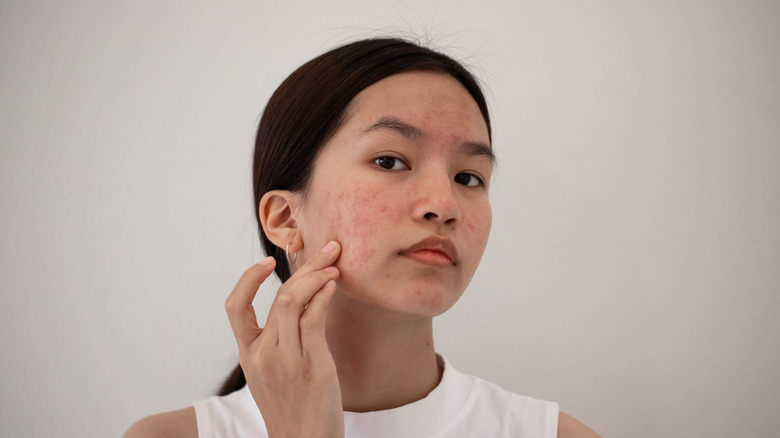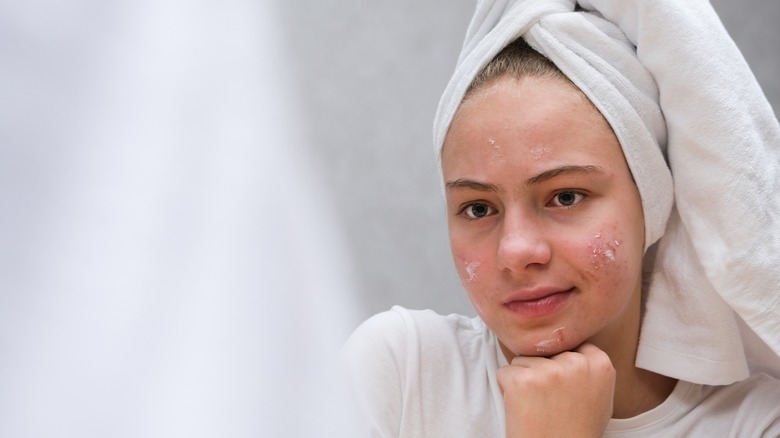Does Amoxicillin Help Treat Acne?
If the word "amoxicillin" sounds familiar to you, it may have been prescribed for you to treat an ear or chest infection, or perhaps a UTI. A penicillin antibiotic, the popular medicine is used to treat bacteria-spread infections and illnesses. While it can only be obtained via a prescription, it comes in multiple forms, such as oral tablets, liquid medicine, or an injection.
Amoxicillin is used to cure a wide variety of infections — everything from dental abscesses, UTIs, and even acne can be treated with the antibiotic. The medicine being used to treat acne may catch you by surprise, but it's actually quite common for antibiotics to be prescribed when getting rid of inflammatory acne.
Breakouts are typically caused by excessive bacteria, which is what antibiotics target. The oral medications also help to reduce inflammation, a side effect of acne. They also help to regulate the amount of sebum that your skin produces, preventing new pimples from forming. While certain antibiotics such as tetracycline and macrolide are used to treat acne, amoxicillin may possibly work as well.
Can you use amoxicillin for acne?
If you have severe acne that can't be fixed using topical treatments, using antibiotics instead can be extremely helpful. Although amoxicillin is typically used for upper respiratory infections, it works for inflammatory acne as well. Amoxicillin takes about three to four months to clear up acne, which is standard for oral antibiotics.
While amoxicillin is effective in eliminating acne, it typically isn't the first choice that dermatologists prescribe. Tetracycline is often prescribed before anything else — changes can be seen within four to six weeks of taking the antibiotic. However, it's not suitable for everyone. Both pregnant people and children under the age of 12 can't take the antibiotic. Additionally, some people have allergies to both tetracycline and macrolide, which is where amoxicillin comes in.
If your acne isn't responding to antibiotics, then oral retinoids such as Accutane are usually suggested. Compared to antibiotics, Accutane is known to eliminate lingering acne that won't clear up. It's also effective for clearing up cystic acne that may not respond to antibiotics. However, Accutane is known to interfere with the effects of birth control.
What are the side effects of taking amoxicillin?
Amoxicillin can transform the skin in a few weeks, but it doesn't come without its fair share of side effects. Among the most common side effects are diarrhea, nausea, vomiting, headache, and changes to the way you taste and smell. The majority of these side effects are quite mild and can be alleviated or prevented by taking the antibiotic with food, sipping on something with electrolytes when you feel nauseous, or taking headache medication.
Some people report allergic reactions after taking the antibiotic. While skin rashes will go away within a few days and can be managed with antihistamines and hydrocortisone cream. If you experience shortness of breath, trouble breathing, or swelling, discontinue the use of amoxicillin and seek medical attention right away.
Antibiotics are helpful, but there's always a risk associated with them. You can always start out with topical treatments, like tretinoin or high-strength azelaic acid. If you're unable to obtain a prescription for these, use over-the-counter retinol, adapalene, benzoyl peroxide, or salicylic acid.


